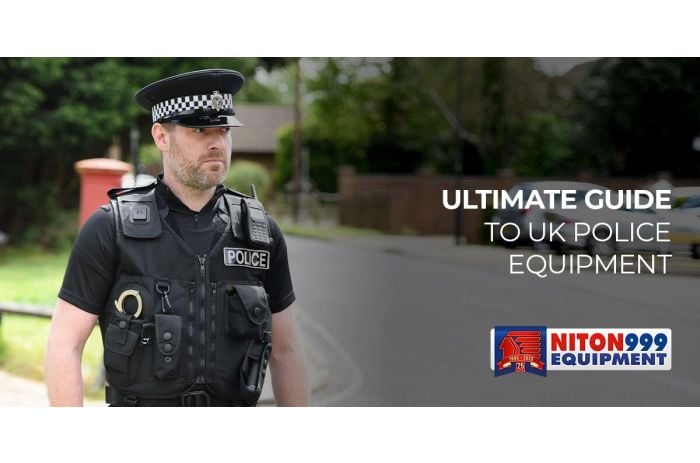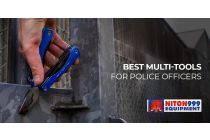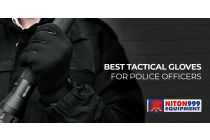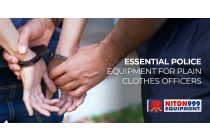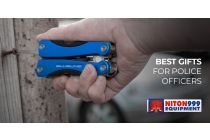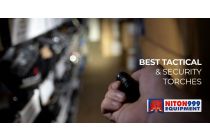Police officers face a broad range of challenges every week.
To be prepared for these challenges, officers rely on various equipment – and selecting the right gear makes a massive difference to safety and comfort.
This guide explores the gear, tools, vehicles and technology used by the police force.
We also discuss the training officers undergo to effectively use these tools and some recommended equipment to buy if you're a police officer or a security professional.
Basic Gear Essentials
This section is a must-read list of police officer equipment list UK.
From the iconic uniform to the essential equipment that keeps officers safe and effective in their duties, understanding these basics offers valuable insight into the daily life and challenges of a police officer.
Uniform
The first and most fundamental uniform on the UK police equipment list is the standard-issue police uniform.
In England and Wales, male constables and sergeants on foot patrol sometimes wear the iconic custodian helmet. Female officers wear a similar version known as the bowler helmet, but this does vary.
The uniform usually consists of a dark-coloured shirt with insignia, trousers, a belt to hold equipment, and sturdy boots suitable for all terrain and weather conditions.
Some forces also issue high-visibility jackets for increased safety during night-time or low-visibility conditions.
Batons
Batons are a key part of an officer's equipment. In the UK, the most commonly used is the expandable baton.

Above: Expandable straight baton
Compact when retracted, these batons can be quickly extended for use. They serve multiple purposes, such as self-defence and gaining control during confrontations. Training on using the baton effectively and ethically is part of standard police training.
Handcuffs
Handcuffs are crucial when restraining individuals who threaten themselves or others.
The handcuffs used by the UK police are typically rigid as opposed to the chain-link style more common in other countries.
This design provides greater control over detainees and reduces the potential for wrist injury. A small key is used to lock and unlock them, and officers often carry a spare key in a separate location as a backup.
Body Armor
Body armour, or "stab vests," are commonly worn by police officers in the UK. These vests protect bladed weapons, pointed instruments, and lower-velocity projectiles.
Officers may use bullet-resistant vests in more dangerous or high-risk situations, which offer additional protection against higher-velocity projectiles. Bullet-resistant vests are typically reserved for armed response units and other special teams.
Radios
Secure and reliable communication is indispensable for police work. Radios are used for real-time contact with the control room and other officers.
These radios are encrypted to prevent eavesdropping and often have emergency buttons that send an alert to the control room in case of immediate danger.
Various attachments like earpieces can also be added for discreet communication.
PPE Kit
Given the ongoing COVID-19 pandemic, personal protective equipment (PPE) has become a standard part of the basic gear for police officers.
This includes disposable gloves and masks and sometimes eye protection. The PPE kit is not only crucial for the safety of police officers but also serves to protect the public and detainees.
Specialised Tools
Beyond the basic gear essentials, police officers may be equipped with specialised tools based on their specific roles, the nature of their assignments, and the risks involved.
Firearms
In the UK, carrying firearms is not standard for all police officers. Only specially trained firearms officers are permitted to carry guns. The UK armed police equipment list might include semi-automatic pistols and carbines.
In extreme cases, such as counter-terrorism operations or hostage rescues, more powerful weaponry like sniper rifles and sub-machine guns may be employed.
These officers go through rigorous selection processes and training programs to ensure they are competent in the use of firearms.
They are usually part of armed response units and are deployed in high-risk situations where firearms are likely required for safely resolving an incident.
The decision to deploy firearms officers is taken very seriously and is usually a last resort aimed at neutralising an immediate threat to life.
Tasers
For less-lethal force options, some units are equipped with taser-stun guns.
These electroshock weapons deliver an electric charge to temporarily disrupt muscle functions without causing substantial injury.
Officers equipped with tasers are specially trained to understand when and how to deploy this tool ethically and effectively, including aiming for areas that minimise potential harm.
Dog Units
The K9 or dog units are integral in various aspects of police work.
Specially trained dogs aid in tasks ranging from tracking and apprehending suspects to detecting drugs, explosives, and even missing persons.
Each dog undergoes a rigorous training program and is paired with a handler, forming a strong working partnership.
Dogs are trained in specific skills related to detecting substances or tracking.
Riot Gear
In public disorder, such as protests that escalate into riots, police officers are equipped with specialised riot gear.
This gear usually includes:
- Riot shields: Typically made from transparent polycarbonate to allow officers to see clearly while providing effective protection from projectiles and hand-held weapons.
- Riot helmets: These provide full-face protection and are often equipped with visors that can be treated to resist impacts and sometimes even flames.
- Protective padding: This includes additional body armour covering the legs, arms, and torso to protect against blunt force impacts.
- Gas masks: Used to protect against the effects of tear gas, which might be used to disperse crowds.
- Batons: While standard officers carry extendable batons, riot police often carry longer, fixed-length batons that provide extended reach and greater control in chaotic situations.
This specialised riot gear is designed to protect officers while allowing them the mobility and effectiveness to safely manage high-tension situations.

Above: Damascus Body Armour System
Police Vehicles
Vehicles are a crucial component of policing in the UK, enabling officers to patrol areas, respond quickly to incidents, and transport detainees, among other duties.
The types of vehicles used by the police vary based on the job's specific requirements. In this section, we'll look at the different types of police vehicles you might encounter in the UK and their roles in law enforcement.
Patrol Cars
The most commonly seen police vehicles on UK streets are patrol cars. These are typically saloon or hatchback vehicles equipped with specialised communication equipment, emergency lights, and sirens.
They're used for various tasks, including patrolling neighbourhoods, responding to emergency calls, and conducting traffic stops.
The interior of a patrol car is designed for functionality, often featuring computer systems that allow officers to access databases, file reports, and stay in communication with dispatch and other officers. They may also contain basic first aid kits and other emergency supplies.
Motorcycles
Police motorcycles are used primarily for traffic control duties and are especially effective in heavy traffic situations where a car would have difficulty manoeuvring.
They are also used for escort duties, such as for VIPs or during public events, and can be an essential component in rapid response due to their agility and speed. These motorcycles are usually high-powered and are equipped with sirens, emergency lights, and communication systems to enable seamless operation with other police units.
Vans
Police vans serve multiple purposes. They are commonly used for transporting multiple officers to and from various locations, especially during large-scale events or operations.
They can also be used to transport detainees in a compartment separate from the driver and accompanying officers.
Some vans are equipped with CCTV cameras for added security and may also feature reinforced panels for increased safety.
Larger vans may be adapted to serve as mobile command units during significant incidents or events, complete with advanced communication and surveillance equipment.
Armed Response Vehicles (ARVs)
These are specialised vehicles designed to transport armed officers and their equipment. Armed response vehicles are usually high-performance cars capable of high speeds and are equipped with a variety of additional features, including:
- Secure storage for firearms and other tactical equipment
- Advanced communication systems
- High-visibility markings and powerful emergency lighting
- First aid kits, including trauma care supplies
ARVs are deployed in situations that are considered high-risk and require a rapid response from highly trained, armed officers.
Helicopters
Police helicopters play a vital role in modern UK policing, offering a unique aerial perspective that can be invaluable in various situations.
They are commonly used in search and rescue operations, high-speed chases, and aerial surveillance.
Equipped with advanced technology like thermal imaging cameras, searchlights, and loudspeakers, these helicopters are an essential tool in locating missing persons, tracking suspects, or overseeing large public events for security purposes.
Tech in Policing
As technology advances, UK police forces increasingly integrate various tech tools into their operations.
These technologies offer new capabilities and enhance the efficiency and effectiveness of traditional policing methods.
Body Cameras
Body-worn cameras have become a standard issue for most frontline officers in the UK. These cameras are typically attached to the officer's uniform and record video and audio of interactions between the police and the public.
Body cameras aim to increase transparency, protect officers from false accusations, and provide valuable evidence in criminal investigations and judicial proceedings.
Officers are trained on when to activate the cameras and how to securely store and manage the recorded data.
Drones
Unmanned Aerial Vehicles (UAVs), commonly known as drones, are increasingly being used by UK police for various tasks, including aerial surveillance, crowd monitoring during large public events, and even search and rescue operations.
Drones can be equipped with high-resolution cameras, thermal imaging, and other sensors, allowing for real-time data collection and analysis. Drones can significantly enhance situational awareness and decision-making capabilities, especially in complex or high-risk scenarios.
Computers and Tablets
In-car computers and handheld tablets have become essential tools for modern policing. These devices allow officers to access a variety of databases, reports, and real-time information while on the move.
Whether checking a vehicle’s registration details, filing incident reports, or conducting background checks, these devices offer on-the-go access to vital information, reducing the need for officers to return to the station and increasing time spent in the field.
ANPR Systems
Automatic Number Plate Recognition (ANPR) systems are used to automatically read and check vehicle registration plates.
These systems can be fixed – mounted on road signs or overpasses – or mobile – mounted on patrol cars. ANPR is used for various purposes, including tracking stolen vehicles, identifying uninsured vehicles, and investigating multiple types of crime.
The data captured by ANPR systems is usually stored and can be accessed as needed for investigations.
Equipment Training
Proper training is crucial when using any type of equipment, whether it's basic or specialised gear. Officers undergo extensive, often scenario-based, training to use each piece of equipment effectively and safely.
This includes properly using handcuffs and specialised training for those authorised to carry firearms. Continuous training and re-certification are common to ensure officers' skills remain current.
Recommended Equipment to Buy
For those considering a career in policing or currently serving officers looking to supplement their standard-issue equipment, here are some recommended items to consider:
Torch
A reliable torch is essential for low-light or night-time situations. It can aid in searching for evidence, navigating dark areas, and even serve as a non-lethal tool for disorienting suspects momentarily.

Above: Niton 999 Original II Torch
Handcuff Keys
It's always good to have a spare set of handcuff keys. These are usually universal and can fit most standard-issue handcuffs.
Gloves
Disposable gloves are essential for hygiene and protection, especially when dealing with substances or situations that may pose a health risk.
Multi-tool
A quality multi-tool can be invaluable in the field for a variety of tasks, from cutting tape to making minor repairs on equipment.

Above: Blueline Multi-Tool
Notepad and Pen
In today's digital age, the importance of a good old-fashioned notepad and pen cannot be overstated.
They are reliable for quick note-taking, jotting down witness statements, or sketching scenes.
Summary
UK police equipment is diverse and varies depending on the officer’s role, police force, and many other characteristics.
While basic gear is more or less continuous across the force, there’s a wide variety of specialist equipment available for different operations.
Niton999 stocks a vast range of police equipment from top brands. We cover the full spectrum of gear, equipping officers with everything they need to thrive in the profession.
FAQs
What equipment do UK police carry?
The basic equipment list for UK police includes uniforms, batons, handcuffs, body armour, radios, and PPE kits. Specialised tools and vehicles vary depending on the unit and task.
What equipment do detectives use in the UK?
Detectives may use unmarked cars, surveillance equipment, and specialised investigative software. They don't typically carry the same range of equipment as uniformed officers but may have access to firearms if qualified.


